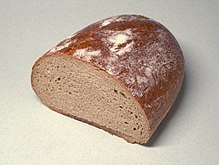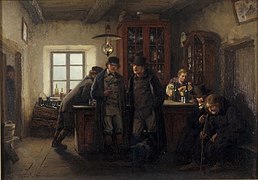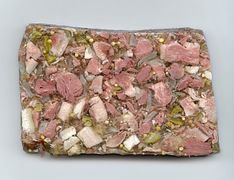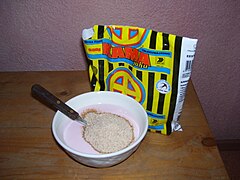Estonian cuisine
| Part ofa serieson the |
| Culture of Estonia |
|---|
 |
| People |
| Languages |
| Cuisine |
| Festivals |
| Religion |
| Sport |
TraditionalEstonian cuisinehas substantially been based onmeatandpotatoes,and onfishin coastal and lakeside areas, however now bears influences from many other cuisines, including a variety of international foods and dishes, with a number of contributions from the traditions of nearby countries.German,Scandinavian,Russian,Finnishand other influences have played their part. The most typical foods in Estonia have beenryebread,pork,potatoes anddairy products.[1]Estonian eating habits have historically been closely linked to the seasons. In terms of staples, Estonia belongs firmly to thebeer,vodka,rye breadand pork "belt" of Europe.
Cold table
[edit]
The first course in traditional Estonian cuisine is based on cold dishes — a selection of pickles, meats andsausagesserved withpotato salad(kartulisalat) orrosolje,an Estonian signature dish almost identical to Swedishsillsallad,based onbeetroot,potatoes andherring.[2]Smallpirogpastries calledpirukad(pirukasin the singular) filled with meat, fish,cabbage,carrots,and other fillings or mixtures are also popular, and are often served withpuljong(bouillon broth).Herringis common among other fish as a part of the Estonian cold table. Smoked or marinatedeel,as well ascrayfish,are considered delicacies. One of Estonia's national dishes is the diminutiveBaltic herring(räim), the national fish of the country, along with thesprat(kilu). Spiced salted sprats on anopen sandwich(kiluvõileib) have been popularised as a distinctive Estonian appetiser.
Soups
[edit]Soupstraditionally formed a main meal option and nowadays are more often eaten as first course. Soups are typically made of meat orchicken stockmixed with a variety of vegetables, eggs, pork or fish. Soups are also blended withsour cream,milk,butterandyogurt.Pea soupis also quite popular.[2]
Main course
[edit]

Black breadleib(orrukkileib,i.e "rye bread") accompanies almost every savory food in Estonia. Estonians continue to value their varieties of black rye-based bread.[citation needed]
Desserts
[edit]Typical Estonian desserts includemannavaht(a cream made ofsemolinaand juice or fruit),kohupiimakreem(creamy curd),kohuke(curd snack),kompott(compote) andkama.A unique form of Estonian dessert isleivasupp( "bread soup" ), which is a type of sweet soup that is made of black bread andapples,normally served with sour cream or whipped cream, often seasoned with cinnamon and sugar.[citation needed]Rhubarbpies are also a favorite.
Another popular dessert iskringel(kringle), a sweet yeast bread often flavored withcardamom.Pancakes(pannkook,pluralpannkoogid) are also traditional, common and popular. They are fried and often have sweet fillings and can be savoury as well.Vastlakukkel,a cardamom-spiced bread roll with whipped cream is a traditional Estoniansweet roll,especially popular during the festivities ofvastlapäev.[3]
Drinks
[edit]Nowadays,locally brewed beeris the number one choice to accompany food;coffee,different juices or simply water being the main non-alcoholic choice.Wineis the second most widely drunk alcoholic beverage, however its consumption in liters is overshadowed by the beer consumption that is roughly 5 times more than the consumption of wine or consumption of all the spirits.[4]There are also Estonian fruit wines made of apples or different berries. Estonia is also known for locally producedviin(vodka) and otherdistilled spirits.Mead(mõdu), the alcoholic drink that was most popular in ancient times, has almost completely disappeared.
Some other drinks whose popularity peaked in the 20th century, however are still consumed by some Estonians, includekali(similar tokvass) andbirch sap(kasemahl) beverages.
Besides milk (piim) other widely consumed dairy products includekeefirand alsohapupiim( "sour milk" ) andpett,which are variations on the theme ofbuttermilk.
Seasons
[edit]Summer and spring
[edit]Traditionally in summer and spring, Estonians like to eat everything fresh—berries, herbs, vegetables and everything else that comes straight from the garden. Hunting and fishing were common in history. Nowadays, they have remained as popular pastimes. It is popular tobarbecuein the summer.[citation needed]
Winter and Christmas
[edit]During the winter months,jam,preserves andpicklesare brought to the table. In the not so distant past, the gathering and conserving of fruits,edible mushroomsand vegetables for winter was more common, nowadays it is less so as almost everything can be bought from stores. However, preparing food for winter is still popular in the countryside and continues to retain its charm for many, as opposed to the commercialization of eating habits.[citation needed]
Oven-grilled pork,blood sausage(verivorst),roast goose(jõuluhani),jellied pork(sült),sauerkraut(hapukapsas) with oven-roasted potatoes, andmulled wine(hõõgvein,orglögi) have been part of the traditional Estonian menu that nowadays are mostly Christmas specialties. Also, typical Christmas treats have been apples,mandarin oranges,gingerbread,pickled pumpkin (kõrvitsasalat), andlingonberry jam.[citation needed]
Gallery
[edit]-
Estonian farmers in aninn,drinkingviin(vodka), painting byOskar Hoffmann,1899.
-
Bread retailed from street counters inTallinn(photo fromThe Encyclopedia of Food by Artemas Ward,1923)
-
Rye bread (leib) is also eaten as a pub snack.
-
Small oven-cookedverivorstblood sausages
-
Traditional sausages at display in an Estonian street market, 2013.
-
World's largestkiluvõileibfish sandwich was created in 2014 in Tallinn.[5]
-
Sült(pieces of meat in jellied porkbrawn).
-
Mulgipuder,a traditional dish of southern Estonia made with potatoes, groats, and meat.
-
Onions and dried fish for sale on a farmer's roadside stand.
-
Kama,a cereal and legume flour is traditionally eaten mixed with just milk or buttermilk, now also used for making desserts.
Notes and references
[edit]- ^Eesti Toit infoserver v2.0.3.0ArchivedDecember 17, 2007, at theWayback Machine
- ^abEstonia By Michael Spilling
- ^Rosa, Natalia (27 February 2020)."A first timer's guide to wholesome and delicious Estonian Food".Trafalgar.Retrieved13 May2023.
- ^"Alcohol market, consumption and harms in Estonia Yearbook 2022".
- ^"Raekoja platsil valmib maailma pikim kiluvõileib".Tallinn.Postimees(in Estonian). 14 May 2014. Archived fromthe originalon 13 October 2016.Retrieved13 October2016.






![World's largest kiluvõileib fish sandwich was created in 2014 in Tallinn.[5]](https://upload.wikimedia.org/wikipedia/commons/thumb/4/4d/Kiluv%C3%B5ileib.IMG_4378.JPG/132px-Kiluv%C3%B5ileib.IMG_4378.JPG)



